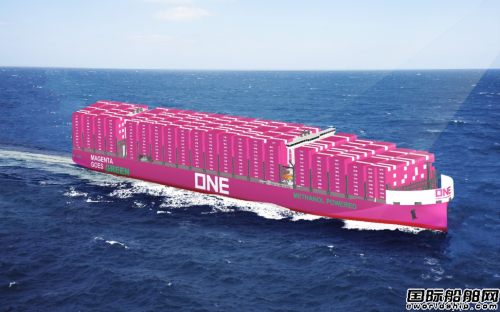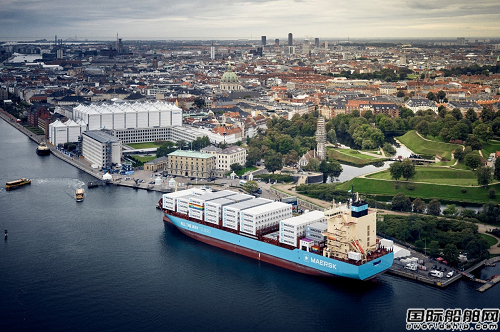Company news
22 vs. 22! Split among shipping giants?
Shipping companies are once again divided over the choice of alternative fuels. Ocean Network Shipping (ONE), a new member that just joined the methanol fuel camp at the beginning of this year, decided to order 10 more ultra-large ships to further expand its methanol-powered fleet; at the same time, Maersk, once regarded as a pioneer in methanol fuel, unexpectedly adjusted its strategy and turned to LNG-powered ships.
A total of 22 ships from the two shipyards! ONE continues to invest in methanol dual-fuel ships
According to foreign media reports, ONE recently returned to Jiangnan Shipyard and Yangzijiang Shipbuilding, ordering 5 13,000TEU methanol dual-fuel container ships at each shipyard. Including the latest order, ONE currently has 11 13,000TEU methanol dual-fuel ships ordered from each of the two shipyards, of which Jiangnan Shipyard is expected to deliver the first ship by the end of 2026 and the subsequent 10 ships between 2027 and 2028, and the 11 ships built by Yangzijiang Shipbuilding will be delivered successively from 2027 to 2028.
The prices of the latest 10 ordered ships have not yet been announced, but according to previous reports, the first batch of 12 ships of the same type ordered by ONE in January this year cost nearly US$170 million each. Based on this calculation, the total transaction amount for all 22 ships will reach US$3.74 billion (approximately RMB 23.527 billion).
For reference, Clarksons data shows that the current newbuilding price of a 13,000/13,500TEU methanol dual-fuel container ship is US$171.5 million, a 3% increase from US$167 million in the same period last year.
It is understood that ONE announced in January this year that it had signed a contract with Jiangnan Shipyard and Yangzijiang Shipbuilding to build 12 13,000TEU methanol dual-fuel container ships. This order marks the birth of ONE's first methanol dual-fuel fleet and is also ONE's first new ship order as a shipowner at a Chinese shipyard.
ONE previously introduced that in addition to the methanol dual-fuel design, this series of ships will also adopt the most advanced technologies, such as optimized hull structure, waste heat recovery system and bow windshield, etc. In addition, it will be equipped with air lubrication system and shaft generator to help explore the potential of improving fuel efficiency and reducing greenhouse gas emissions.

Among them, the six ships built by Jiangnan Shipyard will adopt the "KUN-13M" ship type independently developed and designed by the company, using green methanol as the main fuel, with complete independent intellectual property rights. All performance indicators have reached the domestic advanced level, with the advantages of high efficiency, energy saving, and green environmental protection, meeting the shipowner's strategy and plan to reduce carbon emissions in the fleet during the subsequent operation cycle.
The six vessels will be jointly designed by Yangzijiang Shipbuilding and renowned design institutes, leveraging Yangzijiang Shipbuilding’s strong technical capabilities to meet the changing needs of customers and ensure alignment with the maritime decarbonization agenda.
It is understood that ONE disclosed a fleet expansion plan worth tens of billions of dollars in March 2022, planning to invest 20 billion US dollars in the 2022-2030 fiscal year, of which up to 10 billion US dollars will be used to order new ships, and it is expected that there will be 150,000 TEUs of new shipbuilding investment each year. Another 10 billion US dollars will be used for investment in other areas such as terminals, technology and containers.
In May of the same year, ONE signed contracts with Hyundai Heavy Industries of South Korea and Nihon Shipyard (NSY) of Japan for the construction of five 13,700TEU container ships, which are expected to be delivered in 2025. This is the first time that ONE has placed an order as a shipowner. In March 2023, ONE ordered another 10 13,700TEU container ships from NSY, which are scheduled to be delivered between 2025 and 2026. However, ONE previously ordered methanol fuel-reserved and ammonia fuel-reserved ships from Japanese and Korean shipyards, until this year when it ordered dual-fuel ships for the first time from a Chinese shipyard.
It is understood that ONE was established in 2017 and is a container ship business company jointly established by Japan's Mitsui OSK Lines, Kawasaki Kisen Kaisha and NYK Line. Currently, the three companies hold 31%, 31% and 38% of the shares respectively. ONE, Hapag-Lloyd, Yang Ming Marine Transport and HMM are all members of THE Alliance shipping alliance.
According to Alphaliner data, ONE's current fleet size is 243 ships with a total of approximately 1.92 million TEUs, including 92 owned ships and 151 leased ships, ranking sixth in the world in terms of capacity, with a market share of 6.4%. In addition, ONE has 42 new ships under construction with a total of 540,000 TEUs, and orders on hand account for 28% of the existing fleet. After all new ships are delivered, ONE's fleet capacity will surpass Germany's Hapag-Lloyd and rank fifth in the world.
22 LNG dual-fuel ships? Maersk makes a “big shift” in alternative fuel options
ONE, which placed its first order this year, is the sixth company among the world's top ten container shipping giants to join the methanol fuel camp. Before ONE, Maersk, ranked second in the world, CMA CGM, ranked third, COSCO SHIPPING Group, ranked fourth, Evergreen Marine, ranked seventh, and HMM, ranked eighth, have successively ordered dozens of methanol dual-fuel ships.
Among them, Maersk ordered the first batch of methanol dual-fuel ships in 2021, officially opening the "methanol era" of fuel transformation in the shipping industry. However, there have been recent reports that Maersk is in contact with shipyards and plans to order up to 12 LNG dual-fuel 16,000TEU container ships; at the same time, the orders for 5 LNG dual-fuel 16,800TEU container ships recently undertaken by New Era Shipbuilding from Norwegian shipowner SFL Corp and the world's largest independent container ship owner Seaspan will also be leased by Maersk for a long term.
This is Maersk's first investment in LNG dual-fuel container ships, marking a major shift in the company's fuel transformation process. In recent years, Maersk has been a long-term supporter of methanol fuel. So far, a total of 25 methanol dual-fuel container ships have been ordered from Chinese and Korean shipyards, including the world's first methanol-powered container ship, the 2,100TEU container ship "Laura Maersk" delivered by HD Hyundai Mipo (formerly Hyundai Mipo Shipbuilding) in 2023, and 12 16,000TEU and 6 17,000TEU ultra-large ships expected to be delivered by HD Hyundai Heavy Industries in the next two years; in addition, there are 6 9,000TEU methanol dual-fuel ships from Yangzijiang Shipbuilding, which are scheduled to be delivered in 2026 and 2027.
Maersk has also expressed doubts about LNG fuel many times in the past. At the end of last year, a Maersk spokesperson publicly stated that LNG "is not the future fuel for our fleet" and the company will continue to "invest in technology and innovation to develop new green alternatives to fossil fuels."

Led by shipping giants such as Maersk, methanol fuel replaced LNG last year and became one of the preferred alternative fuels for shipping companies when ordering new ships. According to Clarkson's statistics, among the 184 new container ship orders with a total of 1.5523 million TEUs last year, there were 67 methanol dual-fuel ships with a total of 776,300 TEUs and 35 LNG dual-fuel ships with a total of 497,000 TEUs. In particular, from the fourth quarter of last year to May this year, there were no orders for LNG dual-fuel ships. Until the end of June, New Era Shipbuilding received orders for a total of 28 LNG dual-fuel container ships from four shipowners.
Industry insiders believe that Maersk's switch from methanol to LNG is a last resort under the challenges of green methanol supply and cost. As a relatively mature fuel, LNG has the advantage of being able to significantly reduce carbon dioxide emissions, and the current supply chain is relatively mature. Compared with traditional fuels, LNG fuel can reduce carbon dioxide emissions by about 20%, which means that ships will be able to comply with the upcoming FuelEU Maritime regulations by the end of 2039. After the fuel is mixed with one-third of bio-LNG, the compliance period will be extended to 2050.
However, LNG fuel has also come under fire in recent years. Ships fueled by LNG and the LNG bunkering facilities they need will leak methane into the atmosphere, a gas that is much more serious than carbon dioxide in terms of its global warming effect.
On the other hand, methanol, as a potential alternative fuel for future ships, can greatly reduce emissions of nitrogen oxides, sulfur oxides and particulate matter, is easy to store and handle on board, and has ideal storage and handling facilities in most major ports around the world. Compared with traditional fuels, methanol (green methanol) produced from carbon and hydrogen captured from biomass or renewable energy can reduce carbon dioxide emissions from container ships by 60% to 95%. However, the current supply of green methanol fuel is still very limited. Before green methanol is supplied in large quantities, shipping companies can only use grey methanol or ultra-low sulfur fuel oil, and both fuels are not as effective in reducing carbon emissions as LNG.
It is estimated that the production cost of green methanol is at least twice that of traditional methanol produced from fossil fuels. Moreover, the current green methanol production accounts for less than 1% of methanol production, and most green methanol projects are located in China, Northern Europe and North America, far away from major fueling centers such as Singapore and the UAE, which means additional emissions and transportation costs will be incurred.
In the past few years, Maersk has also invested in several green methanol production projects to ensure sufficient fuel supply for its methanol dual-fuel ship fleet. However, experts pointed out that although Maersk has dozens of green methanol projects in its project library, there are still many uncertainties about how many of them will be implemented and how many will reach the pilot stage.
A recent report by Bloomberg New Energy Finance shows that by 2028, the shipping industry may have a 3 million tonne shortfall of 14 million tonnes of fuel demand for methanol dual-fuel ships. As of early 2024, green methanol production capacity is negligible, accounting for less than 1% of the current 110 million tonnes of methanol production.